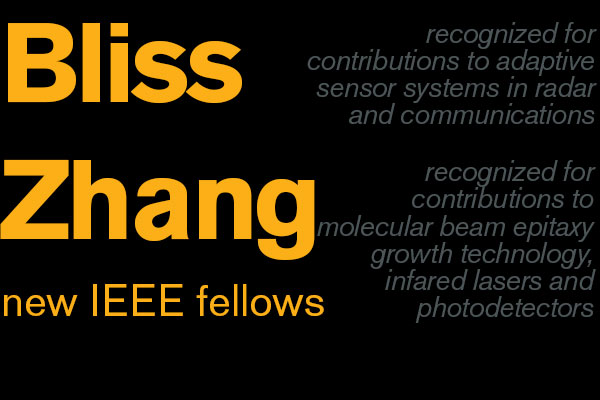
Achievements earn Bliss, Zhang IEEE Fellow status

Outstanding accomplishments in engineering have earned Arizona State University professors Daniel Bliss and Yong-Hang Zhang honored status in one of the world’s most prominent professional organizations.
They are among colleagues selected as new fellows of the Institute of Electrical and Electronics Engineers (IEEE). Fellow is a distinction reserved for the most prestigious IEEE members and is conferred by the Board of Directors upon engineers with an extraordinary record of accomplishments in their field.
The total number of new fellows selected in any one year does not exceed one-tenth of one percent of the total voting institute membership of approximately 400,000 from 160 countries.
Bliss is an associate professor in the School of Electrical, Computer and Energy Engineering, one of ASU’s Ira A. Fulton Schools of Engineering. He is being recognized for his contributions to adaptive sensor systems in radar and communications.
Zhang is a professor in the School of Electrical, Computer and Energy Engineering and associate dean for research for the Fulton Schools of Engineering. He is being recognized for his contributions to molecular beam epitaxy growth technology, infrared lasers and photodetectors.
Bliss’s research is focused on developing novel and disruptive system concepts with new capabilities or dramatically improved performance. In particular, his research addresses wireless communications, remote sensing, and anticipatory medical analytics.
As tools in pursuing his research goals, Bliss employs information theory, estimation theory, and signal processing, combined with thorough system analysis. Many of these system problems involve extracting information in noisy and difficult situations.
Bliss has made numerous significant research contributions in advanced adaptive wireless communications, both as an individual and as a leader of research teams. He has developed high-performance multiple-antenna receivers that have demonstrated experimentally communications performance dramatically better than traditional single antenna systems. Bliss invented and developed high-performance multiple-input multiple-output (MIMO) signal acquisition systems. Both the receiver and acquisition research led to patents.
In the field of remote sensing, Bliss was one of the early and significant contributors to the theory of MIMO radar, particularly in its application to ground moving-target indicator radar. He led a team that was the first to demonstrate the performance benefits experimentally.
Bliss joined ASU in 2012 from the Massachusetts Institute of Technology Lincoln Laboratory, where he was a senior member of the technical staff in the Advanced Sensor Techniques Group. He also brings prior experience from General Dynamics, where he was a member of the superconducting magnet group and designed avionics for the Atlas-Centaur launch vehicle.
Author of the book, “Adaptive Wireless Communications: MIMO Channels and Networks,” Bliss also has published more than 80 journal articles, conference papers, and book chapters. During his career he has been principal investigator on more than a dozen programs with applications in radio, radar and medical monitoring, attracting funding in excess of $20 million. He has advised or co-advised 12 doctoral and 7 master’s degree students, and mentored 11 undergraduates conducting research projects.
Bliss holds a doctoral degree in physics from the University of California, San Diego. He is a proud Sun Devil, having earned his bachelor’s degree in electrical engineering from ASU.
Zhang leads the MBE Optoelectronics Group that is part of the Center for Photonics Innovation, which he directs. His research covers a broad area of optoelectronics involving the growth of semiconductor materials and their structural and optical properties, as well as semiconductor device design, fabrication and testing.
Over the past nine years, Zhang and his research group have developed more than two dozen invention disclosures in the areas of semiconductor lasers and light emitting devices, solar cells, photodetectors, and their integrated systems. Their underlying breakthroughs have applications in several market segments, including terrestrial and space solar cells, optical communication, and sensor technologies for environmental monitoring and defense.
Zhang has published approximately 260 journal articles, proceeding papers and book chapters and given more than 320 invited talks and conference presentations, and holds nine issued U.S. patents. He also has advised 34 doctoral students and sponsored 39 postdoctoral researchers.
Zhang joined the faculty of the Fulton Schools in 1996 from Hughes Research Laboratories. He is a fellow of the Optical Society of America and holds a doctoral degree in solid-state physics from the University of Stuttgart.
Media Contact
Sharon Keeler, [email protected]
480-727-5618
Ira A. Fulton Schools of Engineering





































